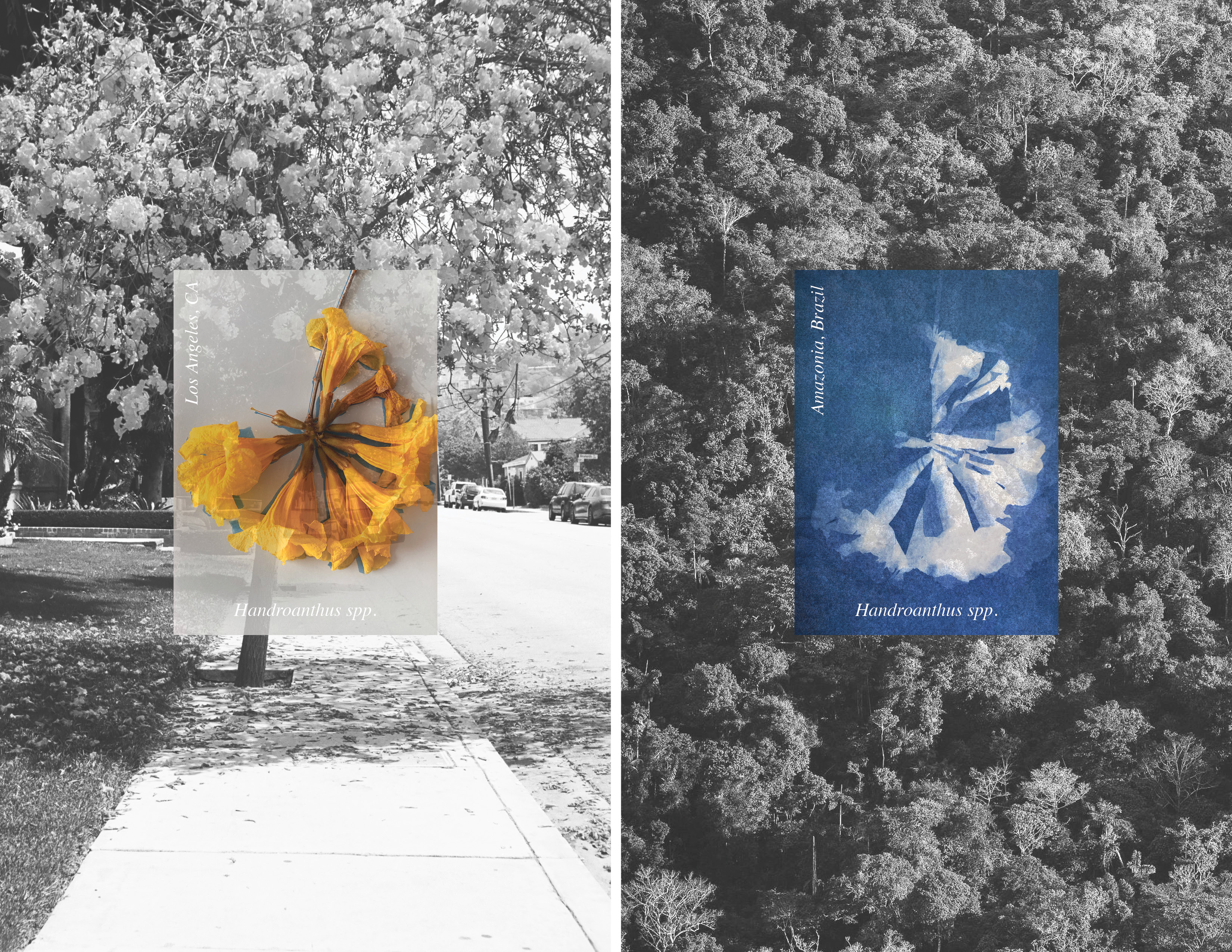Blooming Wounds
Contributor
A Tale of Two Cities
Each spring, Los Angeles fills with pink, purple, and yellow blossoms from the trumpet tree (Handroanthus spp.), or ipê (pronounced ee-PEH)—an Indigenous Tupi word meaning “hard bark.” Native to South America, the tree brings color to the city’s dry streets and connects two distant landscapes through migration and memory.
Yet the same flowering season carries a different meaning in the Brazilian Amazon. When ipê blooms, helicopters fly above the forest canopy to spot their bright crowns. On the ground, loggers mark them for later extraction. The flowers that brighten Los Angeles streets also serve as death markers, signaling erasure elsewhere.
This diptych juxtaposes not just stories of two cities, but of two territories: Los Angeles, where trumpet trees stand in beauty, and the Amazonian Forest, where the same tree fuels one of the world’s most violent and unsustainable timber economies. Together, these geographies illustrate how beauty in one place can be inseparably tied to degradation in another.
The global demand for ipê is driven by its exceptional qualities—dense, durable, and prized for high-end decks, floors, and outdoor furniture—selling for up to $6,500 per cubic meter. 1 Despite its value, ipê is a slow-growing tree: it takes eighty to one hundred years to mature, yet Brazil’s forest management plans are based on thirty- to thirty-five-year cycles. 2 The mismatch between ecological time and market demand creates a system that cannot sustain itself.
Certified forest management exists, but only on 2.5 million hectares—far short of the 16 million hectares experts estimate would be required to meet demand. 3 In practice, most ipê entering the market is sourced illegally. In 2019, only seven percent of ipê wood came from certified forests, 4 the remaining percentage entering supply chains through fraudulent systems, corruption, and violence. 5
The process is as destructive as it is inefficient. In sawmills across Pará and Mato Grosso, outdated equipment wastes more than 60% of each harvested log. Of what remains, only about a quarter meets export quality. 6 The rare tree—found naturally at a density of one individual per ten hectares—must be located, cut, and dragged out, degrading the surrounding forest. Indigenous territories such as Apyterewa and Trincheira Bacajá have become flashpoints: between 2019 and 2020 alone, these lands lost over 14,000 hectares of forest to invasions and logging. 7
Beyond environmental loss, the ipê economy is deeply tied to human exploitation. Illegal timber operations rely on poor workers under brutal conditions, with reports of forced labor and debt bondage. 8 Fraudulent paperwork, known as “heating the wood,” launders illegal logs into the legal market. Corrupt public officials issue permits that disguise the true origin of the timber, creating the illusion of legality. 9 From there, ipê flows to North America and Europe, becoming the decking of luxury homes, galleries, and high-end businesses.
From Los Angeles, these dynamics remain invisible. Walking beneath the trumpet tree’s blooms, one might never suspect their entanglement with violence in Amazonia. The trees, planted as symbols of beauty and shade, were cultivated by the city’s arboretum in the 1960s to be used in landscaping.
The diptych of Los Angeles and Amazonia reveals a paradox: a tree that adorns one city fuels deforestation in another. It tells not just a tale of two places but of entangled economies, where urban landscapes mirror extractive frontiers—and where centuries of growth meet the brief cycles of logging and bloom. In Los Angeles, the value of the trumpet trees is symbolic; in Amazonia, it is measured in cubic meters, dollars, and hectares of loss.
The ipê evokes a sense of belonging in one landscape and dispossession in another—realities divided by distance but bound by global markets. It reminds us of the intertwined fates of cities and forests. To see its blossoms without acknowledging the violence behind them is to miss the story they tell.

- M. Lentini et al., A exploração do ipê (Handroanthus spp.) em florestas naturais da Amazônia brasileira: desafios e oportunidades para a conservação e o manejo responsável. Imaflora, 2021. ↩︎
- K. D. C. Andrade et al., “Volumetric yield coefficient: the key to regulating virtual credits for Amazon wood.” Acta Amazonica, 2022. ↩︎
- M. Lentini et al., A exploração. ↩︎
- Ibid. ↩︎
- Greenpeace Brazil and Tropical Forestry Laboratory of Esalq/USP, Imaginary Trees, Real Destruction. March 2018. ↩︎
- K. D. C. Andrade et al., Volumetric yield coefficient. ↩︎
- F. Maisonnave, “Desmate, Invasões e garimpo se alastram por terras indígenas perto do rio Xingu.” Folha de São Paulo, September 2020. ↩︎
- University of Nottingham, BRICS Policy Centre, Business & Human Rights Resource Centre, Repórter Brasil and Core Coalition, Timber Industry: Modern Slavery and the British Market. Repórter Brasil, 2018. ↩︎
- Greenpeace Brazil, Imaginary Trees. ↩︎